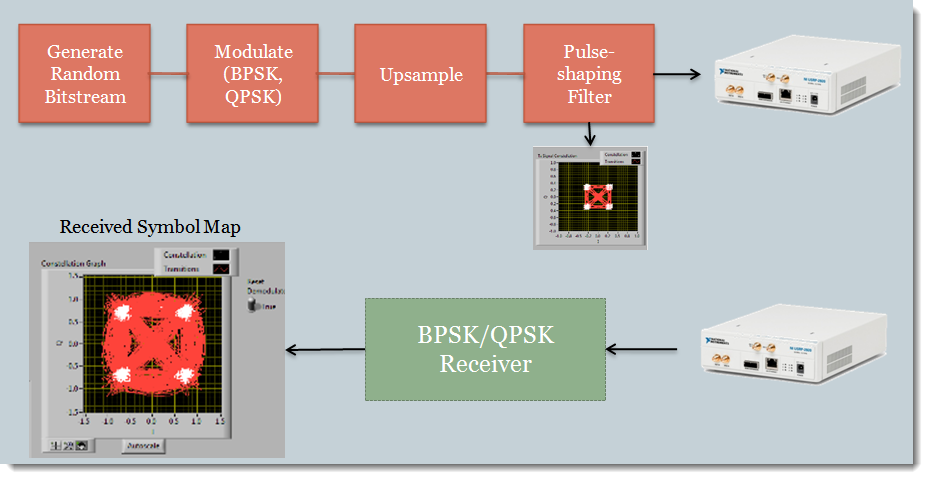From 11:00 PM CST Friday, May 9th - 3:00 PM CST Saturday, May 10th, ni.com will undergo system upgrades that may result in temporary service interruption.
We appreciate your patience as we improve our online experience.
From 11:00 PM CST Friday, May 9th - 3:00 PM CST Saturday, May 10th, ni.com will undergo system upgrades that may result in temporary service interruption.
We appreciate your patience as we improve our online experience.
The goal of this lab is to learn about modulation, and implement the wireless transmitter for a USRP-to-USRP link. Specifically we will be implementing the pulse shaping filter (root raised cosine) and the modulator (BPSK, QPSK).
(Learn more about the NI USRP software defined radio platform.)

This lab is from a course developed at Stanford University entitled Building Networked Systems. The course was first taught with a trial group of students in the Spring 2011 quarter. With the software/hardware combination of LabVIEW and the NI USRP, students were able to build and explore each element of a complete communications system signal chain. The course progression covered topics including channel coding, modulation, demodulation, timing recovery and culminated with students building their own protocol.
Course evaluations affirmed that students were highly engaged in and benefited greatly from the EE 49 class. “The course evaluations for our class were fantastic,” said Katti. “Students rated the class 4.94/5.0, likely making it one of the highest rated among all classes in the School of Engineering at Stanford.”
These materials are considered a work-in-progress and reflect the first run of the course. The course is anticipated to run again in the Spring of 2012.
EE49 Lab 1: Source Coding Lab: Cosine Transform (DCT), sample quantization, and Huffman coding
EE49 Lab 3: Introduction to Modulation: BPSK & QPSK
EE49 Lab 4: Introduction to Demodulation and Decoding: BPSK & QPSK
EE49 Lab 5: Building a Wireless Packet Transmitter and Receiver
LabVIEW Full or Pro
LabVIEW Modulation Toolkit
Two NI USRP-2920
The PDF laboratory procedure is attached along with starting-point VI's for the students.
LaTeX source is included so that it can be customized by the instructor.
Author: Dr. Sachin Katti, Jeff Mehlman, Aditya Gudipati
School/University: Stanford University
I cannot open the RX.vi,it need a password!Is there anyone know that?
Password protected VIs in courseware contain the exercise solution. You
may email the course instructor or if you are a professor our TA, the
courseware author (Dr. Katti) for the password.
im currently working on project ..im at intial stage just want to perform QAM or QPSK modulation and demod using LAbview..
can someone please send me VI's or user manual for that..
thanks....
im currrently working on a project...i m at intial stage of labview and want modulation and demod of either QAM or QPSK or FSk...
would someone can provide me with VI's or STEPWISE manual for that ,,,so that i can proceed further..thanks
Please find the updated version of Modulation VIs in the attachments.
The TX and RX vi's are updated on Labview 2012 to support the NI USRP 1.2 drivers as their previous versions may appear as broken in this case.
Thank you.
Hi,I am working out the this lab and I am stuck at the implementation of "generate PSK symbol Map" vi. to someone give some guidance how to implement this?
hi Erikl, I am student at the University of Applied Sciences and Arts Dortmund. I want to do the lab hence I need passworts. Do you mind give me Dr. Katti mail that I could contact him?
Does this experiment work for usrp-2922?
Hi TeaTea, yes it will run fine. The difference between the 2920, 2921 and 2922 are just the carrier frequency ranges. You just need to change the carrier frequency on the front panel of the transmitter and receiver cod and it will work exactly the same. Up and down conversion will take care of the difference under the hood.
It also works on a 293x or 2900 or 2901, FYI.
Thx a lot for your help, appreciated ![]()
Hello again, is there any manual about this? I get some errors while im running the vi's. Thanks 🙂
Hey TeaTea. It could be a huge number of things and might be tough to troubleshoot over the forums. I would recommend writing down the errors you get and then giving NI a call.
Hmm i'll try that, thanks again 🙂
I have one last question, then im out 🙂 when i execute lab3 it says input bit stream is empty. How do i give an entry stream, could you help me about this?
Thx